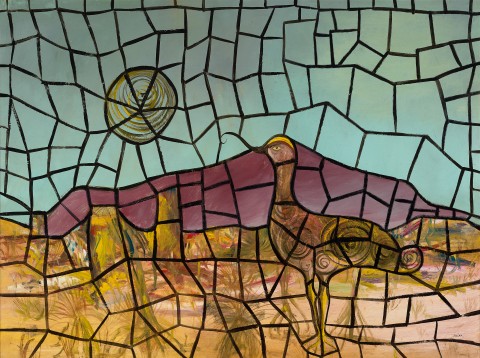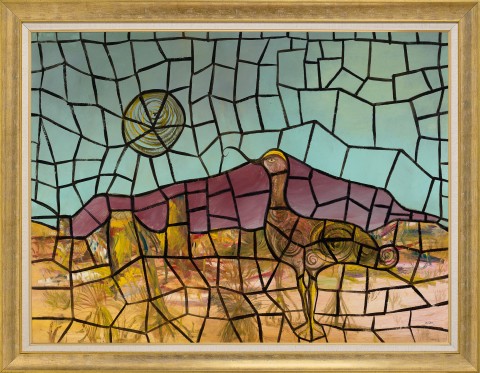BIRD, 1948
SIDNEY NOLAN
Ripolin enamel on composition board
89.0 x 121.0 cm
signed and dated lower right: 4-11-48/ Nolan
signed lower right: Nolan
Estate of the artist, United Kingdom
Important Early Works from the Estate of Sir Sidney Nolan, Bonhams, Melbourne, 20 August 2013, lot 42
Private collection, Sydney, acquired from the above
Sidney Nolan - 102 works from the first fifteen years (1939 - 53), Joseph Brown Gallery, Melbourne, 25 July – 7 August 1979, cat. 36
A Collection of work 1940 - 1970, Australian Galleries, Melbourne, 27 April – 16 May 1992, cat. 11, and touring to: Australian Galleries, Sydney, 9 June – 4 July 1992, cat. 11 (label attached verso, as ’Emu with rocks’, stock no. 8967)
Important Impressionist, Traditional, Modern and Contemporary Art , 69 John Street, Sydney, 1 – 31 August 2014
Sidney Nolan - 102 works from the first fifteen years (1939 - 53), Joseph Brown Gallery, Melbourne, 1979, cat. 36 (illus.)
Swagman, c.1948, enamel on composition board, 122.0 x 91.5 cm, private collection
With poised solemnity and other-worldly whimsy, Nolan’s chimerical Bird, 1948 stands alone in a desolate and vast desert landscape, a topsy-turvy land that has existed since the dawn of time. The exotic strangeness of the Australian landscape to European settler eyes, the myth of its dead desert centre, and the trope of the ill-fated explorer all fed into Sidney Nolan’s paintings in the immediate aftermath of World War Two. These rich themes inspired radical paintings, surreal in character, that provided ‘the sensation of seeing and knowing our own country, both its landscape and its legend for the first time’ – and launched the artist’s international reputation.1
By 1947, Nolan needed to distance himself from the oppressive atmosphere of life with his patrons, the Reeds in Melbourne, and encouraged by his new friend, the young poet Barrie Reid, travelled to Fraser Island in Queensland. This first experience of air travel proved to be transformative for the artist, sparking an enduring fascination for outback Australia and providing a new and unusual aerial perspective for his paintings. Inland Australia and its ethnography was a popular subject at the time, fostered by publications such as Walkabout magazine and Axel Poignant’s aerial photographs, and desert paintings by Hans Heysen, Albert Namatjira and Russell Drysdale.
In 1948, shortly after marrying Cynthia Hansen (née Reed) and settling in Sydney, Nolan set off again with his new family on a remarkable journey to some of the most remote parts of the continent, following Eddie Connellan’s mail-service route through Alice Springs. Cynthia Nolan wrote in her travel notebook that Nolan ‘was both tremendously excited and repelled by the wind, desolation and phenomenal light… Enlivened by his own vision, painting executed with fiery speed, savage scrubbing, tender delicacy and penetrating wit.’2 Here, the sunbaked earth of central Australia, its cracked tessellations overlaying the entire image, surprisingly supports flourishing flora and fauna. The unexpected patterning fracturing this scene shares the ink and enamel transparency of Nolan’s contemporaneous paintings on glass, as well as the austere gridded abstractions of his earliest artworks in 1939. Painted beneath in glossy Ripolin, the continent’s interior of purple cratered peaks, scrubby bush, and a hypnotic spiral sun hanging in a blue sky, is presented as a shimmering primordial landscape.
The spectacular paintings from Nolan’s outback odyssey were exhibited to much acclaim and public enthusiasm at David Jones Gallery in March 1949, introduced by Maie Casey as ‘an Australian myth - the poetic image transmuted from facts into essence.’3 Although Bird was painted in Sydney immediately upon the artist’s return, it was not included in this exhibition and remained in the artist’s collection in Australia from 1950 until after his death. It is intimately linked to this series of paintings of abandoned colonial buildings, swagmen and escaped convicts, native grass trees and paintings of ‘a bird, a weird and wonderful and beautifully comic creature, leaping right across the picture.’4 While some paintings from this time such as Desert bird, 1948 (private collection), Bird, 1948 (private collection), and Pretty Polly Mine, 1948 (Art Gallery of New South Wales), featured birds strangely suspended in the sky, here the large eponymous creature is at one with the landscape, its webbed feet solidly planted in the ground and its curved beak joining the black lines that cover the painting’s surface. It stands stiffly in profile, echoing the heraldic form of the emu and the colonial specimens of John Gould’s Birds of Australia (1848).
1. Tatlock Miller, H., ‘Amazing impact by Australian artist’, Sun, Sydney, 8 March 1949, p. 8
2. Nolan, C., Outback, Methuen & Co Ltd, London 1962, p. 57
3. Maie Casey, cited in Underhill, N., Sidney Nolan. A Life, Newsouth, Sydney, 2015, p. 206
4. ‘Assorted Painters’, The Bulletin, Sydney, vol. 69, no. 3951, 8 December 1948, p. 24
LUCIE REEVES-SMITH


